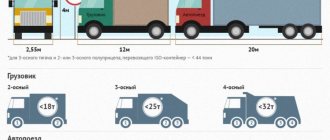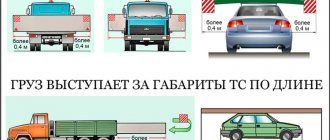Remember the famous thesis expressed by Ostap Bender: “A car is not a luxury, but a means of transportation”? Nowadays it can be supplemented with the words “people and cargo”.
While most motorists have no questions about the rules for transporting passengers, not everyone is familiar with the nuances associated with transporting goods. A whole section is devoted to this issue in the Traffic Rules.
Traffic rules requirements
In the traffic rules, section 23 is devoted to the transportation of goods, consisting of five points, in which the legislator has provided for all possible situations that arise during their transportation by road.
23.1 deals with permissible values for cargo mass. 23.2 requires the driver to control its placement and fastening.
Clause 23.3 of the traffic rules clearly states when the carriage of cargo is allowed and has five paragraphs, of which it is worth mentioning something quite unusual for modern drivers that many drivers forget: the placement of cargo should not interfere with the perception of hand signals.
Oversized cargo: how to load and what to transport.
For many cargo carriers, the transportation of oversized cargo causes some concern, and this is understandable, since the transportation of oversized cargo differs significantly from the transportation of regular cargo.
Transportation of oversized cargo is extremely difficult, and only experienced cargo carriers undertake such work. Oversized cargo is considered to be cargo with a height of more than 4 meters, a width of 2.55 meters, a length of more than 20 meters and a weight of more than 38 tons. Oversized cargo does not have a standard shape and looks different. Oversized items can be pipes, building slabs, equipment, various types of transport, and so on. Most often, oversized goods are non-dismountable cargo and are transported without dismantling.
- 2 Transportation of oversized cargo: rules for loading oversized cargo.
- 3 Weighting of cargo: calculating the center of gravity of the cargo, mass balance and its distribution.
3.1 If an oversized load is improperly secured, the following may occur:
Transportation of oversized cargo: choosing a vehicle for transporting oversized cargo.
For cargo owners, especially beginners, choosing a vehicle for transporting oversized cargo is a big problem, since most vehicles are designed for standard sizes, i.e. for the transportation of cargo with a width of no more than 2.5 meters, a height of up to 3 meters, a length of up to 13.6 meters (European trucks), weighing no more than 20 tons.
Transport companies providing services for the transportation of oversized cargo often use low- loaders and trawls .
Low loaders are cargo platforms that do not have restrictive sides.
Trawls are cargo semi-trailers with increased tonnage (up to 150t), length (up to 16m) and width (up to 4m).
If the oversized cargo has a large mass, then the transport for its transportation is selected taking into account the carrying capacity and the maximum permissible axial load.
When transporting oversized items such as pipes, pipe carriers are used; building materials are most often transported on slab carriers.
Before renting a vehicle to transport oversized items, be sure to find out its weight, length, width and height. Before shipping oversized cargo, make sure it is securely secured to the loading platform.
Transportation of oversized cargo: rules for loading oversized cargo.
Riggers are responsible for securing oversized cargo. Before loading, placing and securing oversized cargo on the loading platform, riggers weigh the cargo.
Weighting of cargo: calculating the center of gravity of the cargo, mass balance and its distribution.
In rare cases, an oversized load has the correct shape, in this case the center of gravity falls on its middle, but most often the shape of the load is not uniform and the center of gravity shifts.
If oversized cargo is improperly secured, the following may occur:
— during maneuvers, cargo can fly off the loading platform in any direction. — it is possible for the vehicle to roll over on its side while making a turn. — when a vehicle brakes, an oversized object can fly out of its fastening, crushing the truck’s cabin.
The cases presented above are the most common when transporting oversized cargo on Russian roads.
Let us remind you once again that when loading and securing oversized cargo onto a loading platform, it is necessary to involve specialists. It is the professionals who will help you draw up a load securing scheme, taking into account the dimensions and center of gravity. For the safe transportation of oversized cargo, the cargo must move in complete balance and only if all parameters during transportation, securing and loading are taken into account, the consignee will receive his cargo intact and safe.
- Author: Anastasia
Rate this article:
- 5
- 4
- 3
- 2
- 1
(1 vote, average: 1 out of 5)
Share with your friends!
Is it profitable to transport your own goods?
What goods can be transported by sea?
Permissible dimensions of cargo for transportation by road
What is considered a large-sized cargo, the transportation of which does not require special permits, but has strictly defined transportation rules specified in the traffic rules?
By lenght
If the load protrudes beyond the front and rear dimensions of the vehicle by more than 1 m, but not more than 2 m. It should be noted here that despite the presence of the letter “and”, you can read “or”. Let’s say the load is extended more than a meter just beyond the rear side of the car, but not in front, it is already becoming large.
Width
It also indicates how much the load can protrude across the width of the car - no more than 40cm.
ATTENTION. Unlike the first case, where the length of the protruding part should be measured from the extreme point of the car, here the measurement is made from the edge of the rear marker light, which means that it will actually protrude slightly less than the prescribed 40cm, since the specified lamp is always located somewhat deeper than the extreme side point car.
If, after measurements, at least one parameter exceeds the above standards, it should be o, and in the dark or in case of insufficient visibility, also with flashlights or reflectors: white in front and red in back.
By height
Despite the fact that clause 23.4 of the traffic rules does not talk about the height of the load, it should be remembered that the load should not exceed four meters above the surface of the roadway (clause 23.5 of the traffic rules).
Let's consider this situation: the cargo does not protrude beyond the dimensions of the vehicle, but reaches a height of 3 meters 85 centimeters from the road surface; the “Large cargo” sign is not required.
Sometimes it happens.
Paragraph 23.5 of the traffic rules defines cargo and vehicles for transportation or passage of which will have to obtain a special permit:
Rules for the carriage of goods (speaking)
Before “diving” into the depths of all kinds of rules and laws, let’s immediately say that we will be interested in cases relating to the transportation of goods up to certain sizes, that is, we will not touch upon the topic of transportation of large-sized cargo. Let's begin. The first thing you should turn to is the traffic rules. There are 2 points worth quoting here:
23.4. A load protruding beyond the dimensions of the vehicle in front or behind by more than 1 m or from the side by more than 0.4 m from the outer edge of the side light must be marked with the identification signs “Large load”, and in the dark and in conditions of insufficient visibility In addition, there is a white light or reflector on the front, and a red light or reflector on the back.
A picture like this would be appropriate here. If the cargo is up to and including the specified dimensions, then a sign is not needed.
Here we can say that if you violated the rules for transporting non-large cargo, that is, up to these limits, then the fine will be minimal or even a warning. (Article 12.21 of the Code of Administrative Offenses of the Russian Federation). This applies to cases:
— does not limit the driver’s visibility; — does not complicate control and does not affect the stability of the vehicle; — does not cover external lighting devices and reflectors, registration and identification marks, and does not interfere with the perception of hand signals; — does not create noise, does not generate dust, does not pollute the road or the environment.
(requirements from the same traffic rules).
If the dimensions “got out” beyond these limits, then we hang up a sign, or rather a “Large cargo” sign. Does this mean that protruding beyond more than 1 meter back and forth, relative to the dimensions, and more than 0.4 m on the sides relative to the side lights, the vehicle will be large? Well, let's turn to Federal Law 257 and find a definition for a large vehicle.
large-sized vehicle - a vehicle whose dimensions, with or without cargo, exceed the permissible dimensions established by the Government of the Russian Federation
Here we can draw an analogy and consider the protruding load to be large.
...if at least one of the dimensions of the vehicle together with the cargo exceeds the established value according to the traffic regulations, the cargo is considered oversized
At the same time, large cargo of certain sizes must be transported according to the rules, in accordance with clause 23.5 of the traffic rules. Let us quote this point as well.
23.5. Transportation of heavy and dangerous goods, movement of a vehicle whose overall dimensions, with or without cargo, exceed 2.55 m in width (2.6 m for refrigerators and isothermal bodies), 4 m in height from the surface of the roadway, and in length ( including one trailer) 20 m, or the movement of a vehicle with a load protruding beyond the rear point of the vehicle's overall dimensions by more than 2 m, as well as the movement of road trains with two or more trailers are carried out in accordance with special rules. International road transport is carried out in accordance with the requirements for vehicles and transportation rules established by international treaties of the Russian Federation.
Please note that we have not only one size left, when the load outreach from the rear is more than 1 meter, but up to 2 meters. In this case, cargo of this size is not required to be transported according to the rules, but it is necessary to attach the “Large Cargo” sign to it.
Actually, we can already draw some conclusions. If the dimensions do not exceed 2.55 m in width, 20 m in length, 4 m from the road in height and 2 meters in the back, then even if it is a large cargo, it is transported without special rules, that is, only in accordance with traffic regulations. If the dimensions are more than that, then according to the Federal Law of the Russian Federation of November 8, 2007 No. 257-FZ “On highways and road activities in the Russian Federation and on introducing amendments to certain legislative acts of the Russian Federation,” road users are prohibited from carrying out transportation of large-sized cargo by road without special permits. We will not talk about these permits, that is, as we said right at the beginning of our article, we only touch upon cases for ordinary motorists, and not for professional carriers. Let's tell you better about the fine if your cargo extends beyond the limits indicated in the last picture.
Transportation rules
On the territory of the Russian Federation, the transportation of large cargo is regulated by a number of regulations, in addition to traffic rules, this includes:
The documents are quite voluminous and informative, covering not only the topic under consideration, so we will consider them in the relevant part.
You should start with the loading rules, the basic norms of which are spelled out in sufficient detail. This includes sorting cargo by weight, namely, heavier ones are located at the bottom to maintain vehicle stability when moving; the cargo must be homogeneous and well secured. It is also prescribed to prevent gaps between loaded products, ordering them to be filled with gaskets.
Homogeneous piece cargo in the body of a vehicle must be stacked in compliance with the same number of tiers and ensuring reliable fastening of the top tier of the stack (clause 36 of Order of the Ministry of Transport No. 7 of January 15, 2014).
Here we are talking about the need to attract escort vehicles, justifying this by the increased danger when transporting large-sized cargo (clause 52 of Order of the Ministry of Transport No. 7 of January 15, 2014).
Paragraphs 53-58 of Order of the Ministry of Transport No. 7 of January 15, 2014. establish escort rules and requirements for escort vehicles. Tractors and (or) State Traffic Inspectorate vehicles can be used as these vehicles (clauses 53-58 of Order of the Ministry of Transport No. 7 of January 15, 2014).
Paragraphs 59 and 60 of the same Order of the Ministry of Transport No. 7 dated January 15, 2014 provide an exhaustive list of situations and conditions under which the transportation of such cargo is prohibited:
List of rules for transporting large items
What do the rules for transporting oversized cargo require:
For transportation of large-sized cargo, a “Large cargo” sign must be attached to a protruding point. It is made of reflective materials. The sign is a square with sides measuring 40 cm, on which there are inclined stripes of red and white colors (their width is 5 cm). You can make it yourself or purchase it ready-made.
In addition, it may be necessary to fix the white and red side lights.
How is it designated?
Due to the increased danger for road users, these cargoes must be marked with the sign “Large cargo” (clause 23.4 of the Traffic Regulations). This sign is installed directly on the load itself at the extreme protruding point.
Consequently, if the load exceeds the established norms behind the vehicle, it is installed at the rear. If in front and behind - in both places, respectively. The same applies to the designation of protruding parts on the sides of the vehicle.
In addition to the sign, it may be necessary to install white and red lights or reflectors, respectively, at the front and rear, but this requirement is appropriate when transporting at night or in conditions of limited visibility.
Rules for the transportation of oversized cargo
In addition to the traffic rules, instructions for transporting large items in passenger cars are contained in the following regulations:
Permitted dimensions
According to clause 23.4 of the Traffic Regulations, a load whose dimensions protrude beyond the front and rear of the vehicle by more than 1 m and on the sides by more than 40 cm is considered large. All items that fit within the specified parameters are considered oversized and do not have any special recommendations for transportation.
Traffic regulations regarding luggage dimensions:
“Oversized cargo” sign - dimensions according to GOST
The “oversized cargo” sign, as drivers often call it, simply does not exist in the legal field of the Russian Federation, since it is a colloquial and simplified name for the “Oversized cargo” identification sign.
The dimensions of the sign are determined in the form of a square with a side of 400 mm and alternating inclined stripes of red and white, each 50 mm wide.
The above parameters are provided for by the state standard GOST R12.4.026-2001, and therefore are mandatory.
It is allowed to apply this sign directly to the cargo itself in the form of a sticker or drawing in accordance with the specified GOST.
IMPORTANT. The sign is made of reflective materials!
This sign can be purchased or made independently. The only difficulty that arises is that the sign must be reflective.
There are two ways to solve this problem. The first is to purchase special paint, which is unlikely to be cheaper than buying a ready-made sign. The second is to shell out for a sign sticker and stick it on any solid base, such as a sheet of tin or a PVC panel. The main thing is to keep the dimensions, don’t take risks, don’t make the sign smaller than what is provided for by GOST.
Vehicle dimensions
LENGTH:
Single vehicle
LENGTH:
The length of the cargo protruding beyond the rear point of the vehicle dimensions must not exceed
WIDTH:
All vehicles
WIDTH:
Isothermal vehicle bodies
HEIGHT:
All vehicles
Note:
The maximum permissible dimensions of cargo, cars and other vehicles specified in this annex include the dimensions of swap bodies and cargo containers, including containers.
A load that protrudes beyond the front and rear dimensions of the vehicle by more than 1 m or from the side by more than 0.4 m from the outer edge of the side light must be marked with the “Large Load” identification marks.
The identification sign “Large cargo” is a rectangular shield measuring 400 x 400 mm with red and white alternating stripes 50 mm wide applied diagonally with a reflective surface.
If a car or other vehicle (with or without cargo) exceeds the above maximum permissible dimensions, such a car is classified as a large vehicle.
Further operation of such a vehicle and transportation of goods on public roads of the Russian Federation is possible only with a special permit.
A special permit for the movement of a vehicle transporting large-sized cargo on public roads is issued by the Federal Road Agency "Rosavtodor" and its subordinate institutions.
Since 2012, it has been possible to submit applications for special permits electronically through the Unified Portal of State and Municipal Services, located on the Internet at www.gosuslugi.ru.
A special permit is issued for one trip or for several trips (no more than ten) of a vehicle along a specific route with similar cargo having the same characteristics (name, dimensions, weight).
Transportation permit
Until now, many motorists who have not encountered the problem of transporting large cargo believe that permission should be obtained from the traffic police. Actually this is not true.
There is a coordination procedure with the State Traffic Inspectorate and it is connected with the duty of this service to determine whether there is a need for cargo escort and in the form of escort (by a carrier with a special car or a traffic police official car).
Permission for transportation is issued by a number of authorized bodies, depending on which roads the route is agreed on: international, federal or municipal. Recently, it has become possible to obtain this permission from the owner of the road, if it is his property.
To begin the procedure for obtaining a special permit, you must submit the appropriate application to the authorized body (see table above), a package of documents is attached to the application: for the car that will be involved in transportation, for the cargo, and the route map. The authorized body also has the right to request additional documentation related to the upcoming transportation.
The time frame for consideration of the application is specified in the administrative regulations and, depending on the number of approvals and related actions (assessment of the condition of the road or the need for strengthening or reconstruction), from five to thirty days.
Obtaining a special permit is a conditionally free procedure. The authorized body has no right to demand a fee for issuing a permit. But the applicant is obliged to pay a state fee in the amount of 1,600 rubles (clause 111 of paragraph 1 of Article 333.33 of the Tax Code of the Russian Federation (part two) dated August 5, 2000 No. 117-F3, as amended by Federal Law dated July 21, 2014 N 221-FZ ).
Additionally, it may be necessary to pay for an assessment of the road for suitability for transporting the cargo in question, as well as work to strengthen or reconstruct sections of the road and engineering structures (for example, bridges) along the planned route. As well as compensation for damage caused by transportation to roads and communications.
What is the penalty for violation
Responsibility for violation of the rules for the transportation of goods is provided for in two articles of the Code of Administrative Offenses of the Russian Federation.
Article 12.21 - Violation of the rules for the carriage of goods. Sanction: warning or fine in the amount of 500 rubles.
This article applies to cargo that does not require special permission and liability may arise in an approximate number of cases: the absence of a “Large cargo” sign, the cargo is noisy, dusty or not securely fastened, making it difficult to see.
IMPORTANT. There is no sanction for deprivation of the right to drive a vehicle, but according to Article 23.3 of the Traffic Regulations, further movement until the identified violations are eliminated is prohibited, and registration of a violation does not give the right to continue the trip.
Article 12.21.1 of the Code of Administrative Offenses of the Russian Federation provides for liability for violating the rules of movement of a large vehicle. And here we are talking specifically about cargo that requires special permission. In total, the article has 11 parts:
As you can see, the types of punishments are quite harsh, and parts 3.5 and 6 of Art. 12.21.1 provide for the deprivation of the right to drive a vehicle for various periods.
IMPORTANT. For violations provided for in Part. 1-6 Article 12.21.1, the provision of Article 27.13 of the Code of Administrative Offenses prescribes the detention of the vehicle and its placement in a specialized parking lot until the identified violations are eliminated.
A small nuance
Please note that for special rules for the transportation of goods, paragraph 23.5 of the traffic rules sets the norm at two meters from the rear point
car. How far can he protrude from the front? Not a word, therefore, according to the principle “everything that is not prohibited is permitted,” there are no specific restrictions.
It turns out that if the other conditions for length, width and height are not violated, if the load does not limit the view, does not deprive the car of stability and controllability, the sign “Large cargo” is installed and special permits are not required in this case.
Characteristics of oversized cargo
The dimensions and weight of many types of goods exceed the maximum permissible limits. Their transportation is permitted, but is regulated by traffic rules.
Depending on how much the characteristics of the transported items differ from the permissible ones, the conditions for allowing equipment on the roads differ. If the luggage being transported protrudes from the rear beyond the vehicle by a distance of up to one meter, and across the width of the vehicle by 0.4 m, a “Large Load” sign should be posted, white lights and reflectors installed in the front and red ones in the rear.
If the transported objects protrude from the rear of the truck by more than 2 m, and the height of the object exceeds 4 m, special rules established by the Government and the Ministry of Transport apply.











